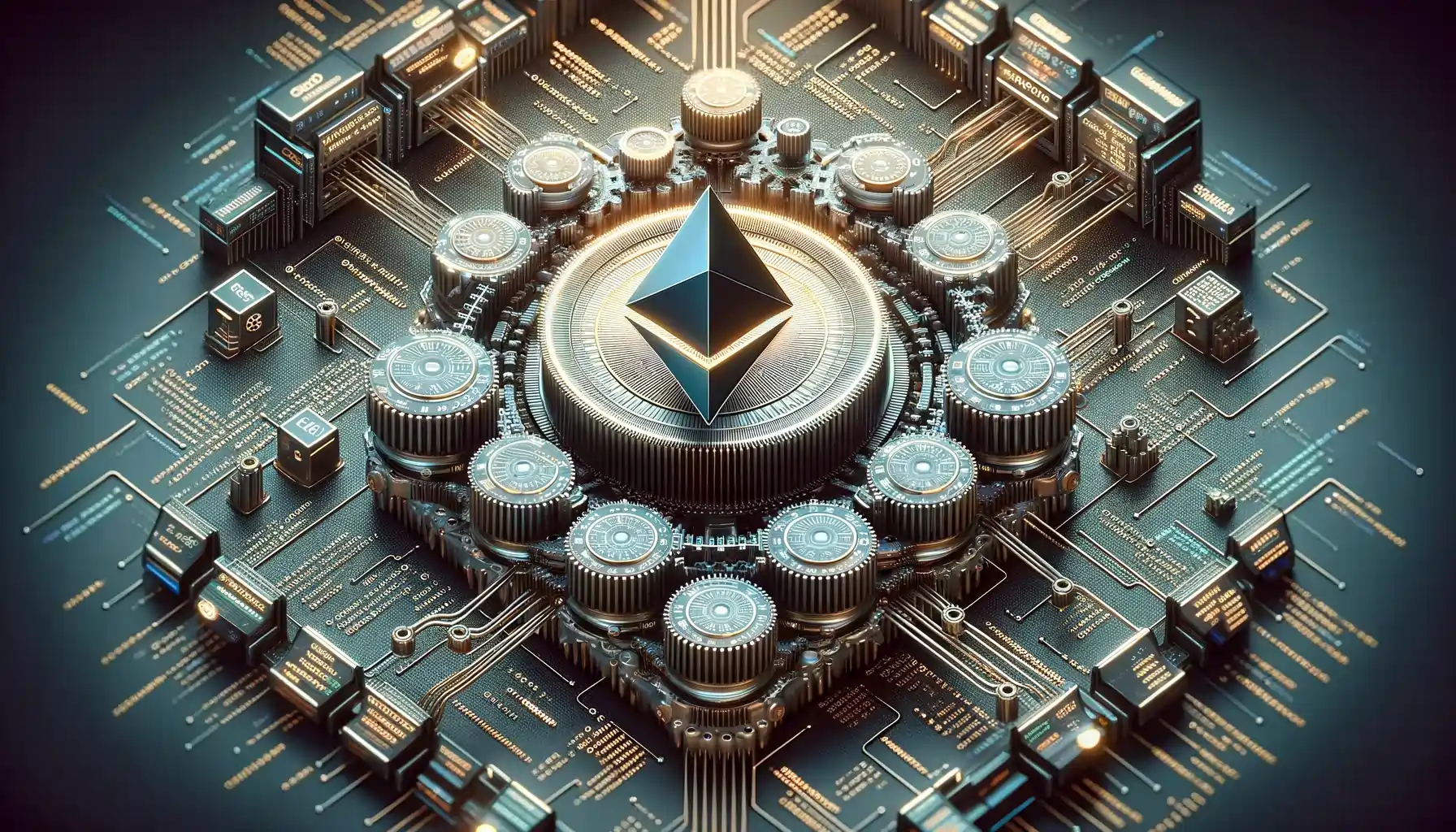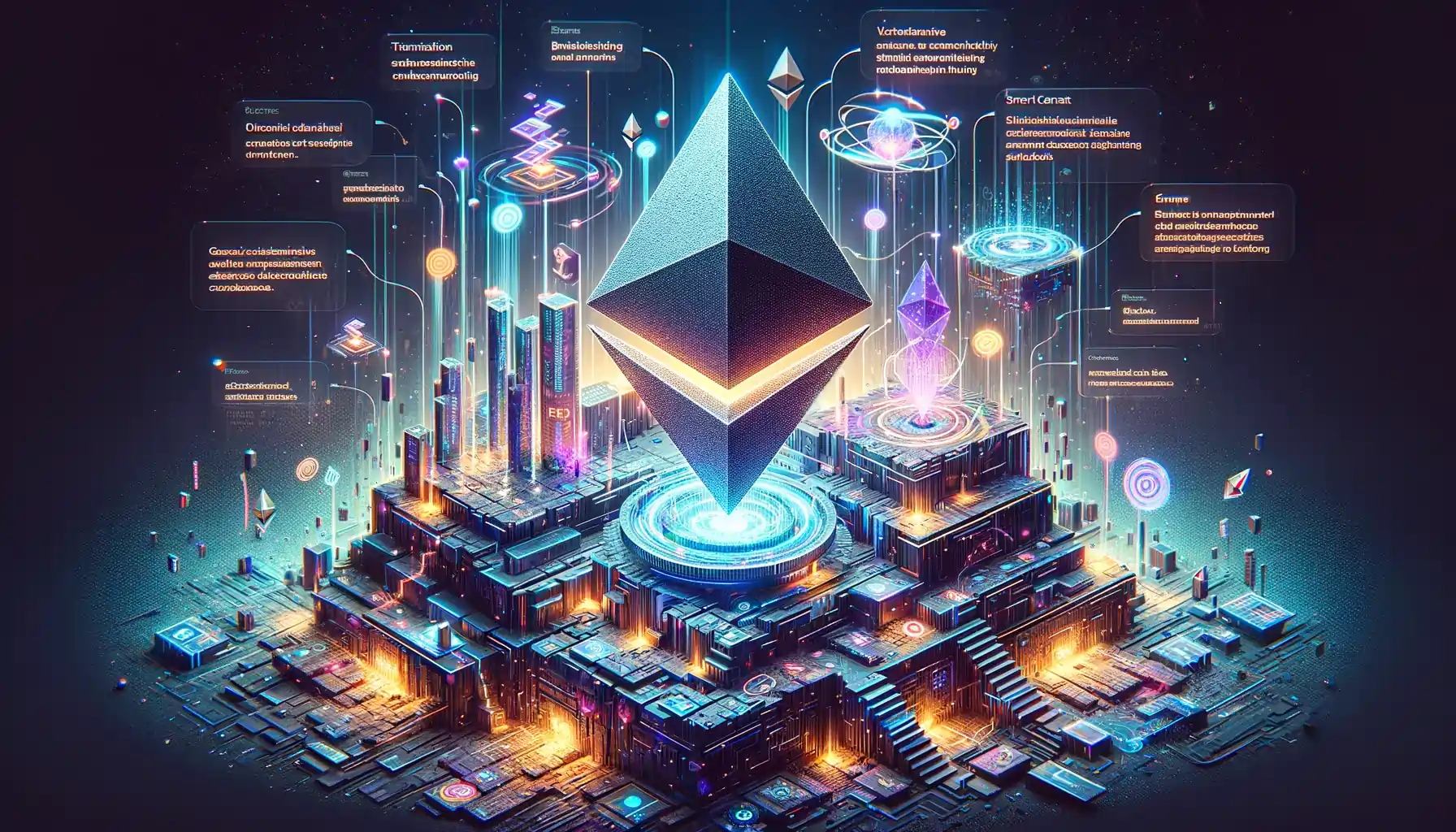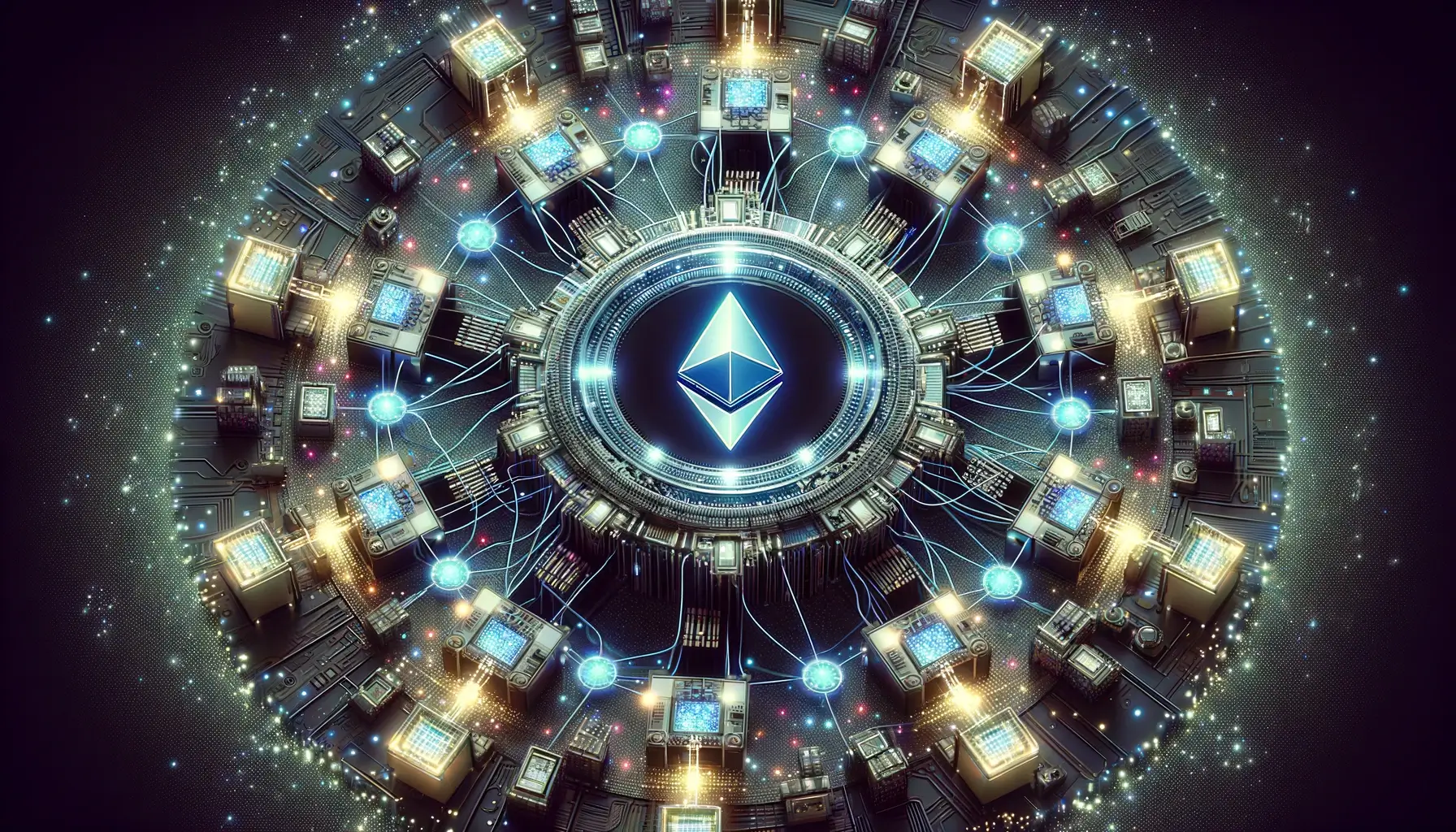Understanding what Ethereum Virtual Machine is is something that usually takes time, but in this article we’ll break down everything you need to understand it in just a few minutes.
Far more than just a component of Ethereum, the EVM is the heart and soul of it, transforming it from a simple ledger to a powerful distributed state machine. No obstante entender qué es Ethereum Virtual Machine
This is where Ethereum’s true power and innovation lie. Through the EVM, Ethereum evolves beyond the boundaries of traditional blockchains, enabling the creation and execution of smart contracts in Solidity.
These contracts are the gears that turn the Ethereum machine, facilitating everything from token generation to complex decentralized applications. Without the EVM, Ethereum’s ecosystem would be nothing but a pipe dream.
The EVM isn’t just a part of Ethereum’s infrastructure; it’s the backbone that defines it and paves the way for a future where decentralized systems reign supreme.
Understanding the Ethereum Virtual Machine (EVM)

To understand the crucial component that is the EVM, one first needs to begin at the very base level by asking the simplest question of all:
What is Ethereum virtual machine?
The Ethereum Virtual Machine, commonly referred to as the EVM, is the engine that powers the Ethereum network. As a crucial part of the Ethereum ecosystem, it’s not just a virtual machine; it’s a complete environment that allows for the execution and management of smart contracts.
The EVM stands out due to its unique role in maintaining a consensus across the decentralized network of Ethereum nodes, ensuring that every node agrees on the current state of the Ethereum blockchain.
The EVM operates as a state machine. This means it keeps track of every operation happening within the Ethereum network, from the execution of smart contracts to simple ether transactions.
It’s in this environment where the Ethereum blockchain transitions from one state to another – a process that occurs with every block added to the chain.
Here’s a breakdown of what this means:
- The Ethereum Blockchain as a State Machine: At its core, the Ethereum blockchain can be thought of as a state machine. This means it maintains a certain ‘state’ at all times, which includes all account balances, smart contracts, and other relevant data.
- Role of the EVM: The Ethereum Virtual Machine (EVM) is the component that processes all transactions and smart contract executions. Each transaction or contract execution can change the state of the blockchain. For example, if a transaction transfers Ether from one account to another, the EVM updates the balances in both accounts, thereby changing the blockchain’s state.
- Block Addition and State Transition: The Ethereum blockchain is made up of a series of blocks, each containing a group of transactions. When a new block is added to the blockchain, the EVM processes all the transactions in that block. This process involves updating the state of the blockchain to reflect these transactions. For instance, if the block contains several transactions transferring Ether, executing smart contracts, or creating new contracts, the EVM updates the blockchain’s state to reflect these changes.
- Continuous Process with Each Block: This state transition is not a one-time event but happens continuously with every block added to the chain. Each new block brings about a new state, reflecting all the changes (like transfers, contract executions, etc.) that occurred in that block.
The Operational Mechanics of the EVM

Smart Contract Execution: The EVM’s Specialty
One of the primary functions of the Ethereum Virtual Machine (EVM) is to execute smart contracts. These contracts, written in languages such as Solidity, define a set of rules and actions that are automatically carried out when certain conditions are met. When a smart contract is activated, either by a transaction or another contract, the EVM comes into play.
The process begins with the EVM reading the contract’s code. This code, initially written in a high-level programming language, is compiled down into EVM bytecode before deployment on the Ethereum network. The EVM then interprets this bytecode and executes the contract’s instructions.
EVM’s State Transition Function
Every action within the Ethereum network, whether it’s a simple transaction or the execution of a smart contract, results in a change in the Ethereum state. The EVM is responsible for ensuring these state transitions occur correctly.
It processes the instructions in the smart contracts, calculates the resulting state changes, and updates the Ethereum blockchain accordingly. This process is crucial for maintaining the integrity and consistency of the Ethereum blockchain.
Gas: The Fuel for EVM Computation
A key aspect of executing smart contracts on the EVM is the concept of ‘gas’. Gas measures the computational effort required to execute operations. Each opcode in a smart contract requires a certain amount of gas to execute.
The total gas cost of a transaction must be paid by the user initiating the transaction, ensuring that the network’s computational resources are used efficiently and safeguarding against spam or excessively complex operations.
The gas system also plays a role in the Ethereum network’s economic model. Miners, who validate transactions and add them to the blockchain, are compensated with these gas fees. This incentivizes miners to continue supporting the network and contributes to Ethereum’s overall security and functionality.
We will unpack this in more detail later in our article.
EVM Compatibility and Interoperability
The EVM is designed to be compatible with various programming languages and interoperable with multiple blockchain environments. This feature has led to the creation of EVM-compatible blockchains, which expand the reach and influence of the EVM’s architecture beyond the Ethereum blockchain itself.
These compatible blockchains benefit from the EVM’s robust smart contract execution capabilities, further demonstrating the EVM’s pivotal role in the broader blockchain ecosystem.
The Technical Nitty-Gritty of EVM

Understanding EVM’s Turing Completeness
A defining characteristic of the Ethereum Virtual Machine is its Turing completeness. In simple terms, this means the EVM is theoretically capable of solving any computation problem, given enough time and resources.
This is made possible by the EVM’s ability to execute a wide range of operations, from basic arithmetic to more complex instructions necessary for running smart contracts. Turing completeness is vital for the flexibility and adaptability of smart contracts on the Ethereum network, allowing them to handle an array of tasks and logical processes.
EVM Code and Runtime Environment
Smart contracts are written in high-level programming languages like Solidity or Vyper and are then compiled into EVM bytecode. This bytecode is what the EVM interprets and executes.
The EVM provides a runtime environment for this bytecode, functioning in an isolated manner. This isolation is crucial for network security, ensuring that executing code on the EVM doesn’t threaten the stability and safety of the wider Ethereum network.
EVM bytecode operates in a stack-based architecture. This architecture is efficient for executing the type of operations required in smart contracts.
In this context, the EVM maintains a stack to keep track of operations, a memory to temporarily store data, and a storage component that holds data persistently on the blockchain.
Handling Data and State
The EVM is not just about executing code; it’s also about managing data and maintaining the state of the Ethereum blockchain. Each smart contract has its own storage space on the blockchain where it can maintain its state.
The EVM updates this state as per the rules defined in the smart contract code. This capability to store and update state is what makes Ethereum a state machine and not just a distributed ledger.
EVM Opcodes and Gas Costs
The EVM operates using a set of instructions known as opcodes. These opcodes are the most granular level of instruction in the Ethereum environment. Each opcode has a specific gas cost associated with it, reflecting the computational effort required to execute it.
The gas system plays a dual role: it prevents the network from being clogged by inefficient or malicious code and provides a mechanism for transaction fee calculation.
Challenges and Limitations
Despite its capabilities, the EVM faces challenges, particularly in terms of scalability and gas costs. High transaction fees can occur when the network is congested, impacting the usability and accessibility of Ethereum.
Ongoing development efforts in the Ethereum community aim to address these challenges, seeking to enhance the efficiency, scalability, and overall performance of the EVM.
EVM and the Ethereum Network: A Collaborative Force

Seamless Integration with Ethereum Blockchain
The Ethereum Virtual Machine (EVM) stands as a cornerstone of the Ethereum network. It plays a pivotal role in processing and executing smart contracts, thereby directly influencing the state of the Ethereum blockchain.
This seamless integration ensures that every transaction and contract execution is uniformly processed across the network.
Ethereum Nodes: Powering the EVM
- Role of Nodes: Ethereum’s strength lies in its vast network of nodes. These nodes, which are essentially individual computers, host the blockchain and are responsible for validating and processing transactions.
- EVM on Each Node: Every node runs an instance of the EVM, contributing to the decentralized and resilient nature of the network. This decentralization ensures that the blockchain remains secure and operates without the need for a central authority.
Smart Contract Execution: A Network-wide Process
- Deployment and Verification: Deploying a smart contract on Ethereum involves nodes across the network. These nodes verify the contract’s code and the conditions for its execution.
- Execution and State Change: Post-verification, the EVM executes the smart contract, leading to state changes in the Ethereum blockchain. These changes are then synchronized across all nodes, maintaining a consistent and updated state of the network.
Resource Management and Gas Fees
Computational Resources: Executing smart contracts on the EVM requires computational resources, measured in terms of ‘gas’.
Gas Fees as Incentives: Users pay gas fees to compensate for the computational efforts of the nodes. This system not only incentivizes miners to maintain the network but also safeguards it from inefficient or malicious code.
The EVM’s Critical Role in Ethereum
The EVM is not merely a component; it’s the driving force behind Ethereum’s capability as a platform for decentralized applications.
Its compatibility with various programming languages and Turing-complete architecture empowers developers to innovate, creating everything from simple token systems to elaborate decentralized platforms.
EVM’s Influence Beyond Ethereum: Compatibility and Interoperability

As we delve deeper into the Ethereum Virtual Machine (EVM), it’s essential to recognize its influence that extends beyond the Ethereum blockchain itself.
The EVM is not just a fundamental part of Ethereum; it has become a standard in the world of blockchain technology, influencing a range of other blockchain platforms. This influence is primarily seen through its compatibility and interoperability features.
EVM’s Compatibility with Other Blockchains
The concept of EVM compatibility has emerged as a significant factor in the blockchain landscape. Various blockchain platforms have adopted EVM-compatible environments, allowing them to leverage the robust smart contract execution capabilities of the EVM.
This compatibility means that developers familiar with the Ethereum platform can easily transition to these other blockchains, bringing their expertise and innovations with them.
For instance, networks like Binance Smart Chain have gained popularity by offering an EVM-compatible environment, thus enabling a seamless experience for Ethereum developers.
Interoperability: Expanding the Reach of EVM
Interoperability is another critical aspect of the EVM’s broader influence. The ability of different blockchain networks to interact with each other is vital for the long-term success and practical utility of blockchain technology.
By fostering an environment where EVM-compatible blockchains can communicate and share information, the Ethereum ecosystem extends its reach and utility, making it an even more valuable resource for developers and users alike.
Impact on Decentralized Applications
This compatibility and interoperability have a profound impact on the development and deployment of decentralized applications (dApps). Developers are not confined to the Ethereum blockchain; they can build dApps that leverage the strengths of multiple blockchain networks.
This flexibility significantly enhances the potential and scope of what can be achieved with dApps, paving the way for more innovative, efficient, and user-friendly applications.
The Future of EVM in the Blockchain Ecosystem
Looking ahead, the role of the EVM in the broader blockchain ecosystem seems poised for continued growth and evolution. As more platforms embrace EVM compatibility and interoperability, the potential for innovation in the blockchain space expands exponentially. This trend underscores the EVM’s status as a critical and influential technology in the world of blockchain and cryptocurrency.
Gas System in the EVM: Balancing Resources and Costs
In the Ethereum Virtual Machine (EVM), the concept of gas is foundational, serving as both a measure of computational resources and a safeguard for the network. Every operation, whether a part of executing smart contracts or processing simple transactions, incurs a gas cost. This cost reflects the computational efforts and resources used by the nodes in the Ethereum network.
Smart contracts on the EVM vary in complexity, and accordingly, their gas requirements can range significantly. More complex smart contracts naturally consume more gas, leading to higher costs. This design compels developers to write efficient smart contract code, as inefficiencies could result in prohibitive gas costs.

However, the EVM’s gas system is not without its challenges. High transaction fees, often a result of elevated gas costs during periods of network congestion, have become a significant issue within the Ethereum ecosystem. These costs can fluctuate unpredictably, affecting both users and developers and posing a barrier to Ethereum’s broader adoption and usability.
Despite its challenges, the gas system plays a critical role in maintaining the network’s integrity. It deters inefficient or malicious contracts by assigning a cost to computational efforts. However the variability and potential for high costs also present hurdles, especially during times of high network activity.
Efforts are ongoing within the Ethereum community to address these challenges. Upgrades to the Ethereum protocol, along with the development of layer-2 solutions, are focused on creating a more efficient, scalable, and user-friendly environment.
The overarching goal is to optimize the gas system, reducing costs while upholding the security and robustness of the Ethereum network. These advancements aim to strike a balance, making the Ethereum ecosystem more accessible and practical for a wider range of users and applications.
The Versatility of the Ethereum Virtual Machine (EVM) in Smart Contract Deployment and Execution
The versatility of the EVM extends far beyond the Ethereum blockchain, impacting a wide array of EVM compatible blockchains. This adaptability ensures that the EVM is not just confined to Ethereum’s infrastructure but also plays a role in the broader blockchain ecosystem.
The process of writing smart contracts – the backbone of any decentralized application – is significantly streamlined by the EVM’s architecture. Developers can write smart contracts in languages such as Solidity, which are then deployed seamlessly across Ethereum and other EVM compatible blockchains.

Developers leverage these languages to craft the logic and functionality of smart contracts. Once written, these smart contracts are not confined to the Ethereum blockchain alone. Thanks to the EVM’s versatile nature, these contracts can be deployed across not only Ethereum but also a variety of other blockchain platforms that are EVM compatible.
Moreover, the EVM intricately manages Ethereum addresses, each representing a unique entity on the blockchain. These addresses are essential in smart contract deployment and execution, serving as points of interaction for users, contracts, and transactions. The EVM’s ability to handle these addresses with precision further accentuates its critical role in the secure and efficient functioning of the Ethereum network and its counterparts.
Let’s dive deeper in this section:
- Smart Contract Deployment: The First Step in EVM’s Workflow – Smart contract deployment on the Ethereum blockchain is a fundamental process facilitated by the Ethereum Virtual Machine (EVM). Developers write smart contracts in languages such as Solidity or Vyper, which are then compiled into EVM code. This code is deployed onto the Ethereum blockchain, where it becomes a part of the distributed ledger. The deployment process is a critical step in creating decentralized applications (dApps) and other blockchain-based solutions.
- Executing Complex Smart Contracts on EVM – Once deployed, the EVM executes these smart contracts, following the predefined logic and conditions set in the code. The execution of smart contracts can range from simple transactions to running complex smart contracts involving intricate interactions and data management. The EVM’s ability to run complex smart contracts is a testament to its power and versatility, making it a crucial component of the Ethereum ecosystem.
- Custom Smart Contracts and Turing Completeness – The EVM’s Turing complete system allows for a high degree of flexibility in smart contract functionality. Developers have the freedom to create custom smart contracts tailored to specific needs and objectives. This flexibility, coupled with the EVM’s robust execution environment, ensures that even the most complex contracts are executed accurately and securely.
- Interoperability with EVM Compatible Blockchains – The influence of the EVM extends beyond the Ethereum blockchain. Many EVM-compatible blockchains have emerged, enabling developers to leverage the familiar environment of the EVM while benefiting from the unique features of these alternate blockchains. This interoperability is a significant advantage, promoting innovation and expansion within the blockchain space.
Technical Architecture and Execution Process in the EVM

EVM Code and Smart Contract Execution
The Ethereum Virtual Machine (EVM) operates at the heart of smart contract execution on the Ethereum blockchain. Developers write smart contracts using programming languages like Solidity or Vyper.
These contracts are then compiled into EVM code, a set of low-level instructions or opcodes that the EVM can interpret and execute. The EVM executes smart contracts in a stack-based architecture, ensuring efficient and secure code execution.
Smart Contract Functionality and Complex Operations
The EVM is adept at running complex smart contracts, which can perform a variety of functions beyond simple transactions. This includes managing decentralized applications (dApps) and executing custom smart contracts tailored to specific needs.
The Turing completeness of the EVM allows for executing these contracts with conditional statements and loop operations, essential for the sophisticated functionality that developers expect.
EVM Compatible Blockchains and Ethereum Protocol
The influence of the EVM extends to many EVM compatible blockchains. These blockchains maintain compatibility with the Ethereum protocol, allowing for the seamless execution of Ethereum-based smart contracts.
This compatibility is crucial for developers who want to leverage the robustness of the EVM while exploring the features of other blockchains like Binance Smart Chain.
Runtime Environment and Ethereum’s Decentralized Network
The EVM provides a runtime environment for smart contract code, acting as a virtual computer within the Ethereum network. This environment ensures the isolated execution of code, protecting the network from malicious contracts and maintaining the decentralized ledger’s integrity.
Ethereum nodes across the network collectively host this virtual machine, contributing to the decentralized network’s resilience and security.
The EVM’s Role in Storing Data and Managing Resources
In executing smart contracts, the EVM also plays a vital role in storing data and managing computational resources. The gas system of the EVM measures the computational effort required for transactions and contract execution, ensuring efficient resource utilization.
This system helps manage the gas costs associated with executing code on the Ethereum network, addressing concerns like high transaction fees.
Ethereum Virtual Machine (EVM) – The Keystone of Ethereum’s Blockchain Revolution

The Ethereum Virtual Machine (EVM) stands as the cornerstone of Ethereum’s evolution, elevating it beyond a simple cryptocurrency platform to a robust ecosystem for decentralized applications (dApps).
Operating at the network’s core, the EVM ensures consensus among nodes and facilitates the secure execution of smart contracts, written in languages like Solidity or Vyper. Its Turing completeness allows for versatile contract functionalities, demonstrating its adaptability and significance in the Ethereum landscape.
Despite challenges such as high gas fees, the EVM’s gas system efficiently manages computational resources, preserving network integrity.
With its ability to execute diverse smart contracts and its interoperability across multiple chains, the EVM continues to shape the future of decentralized systems.

